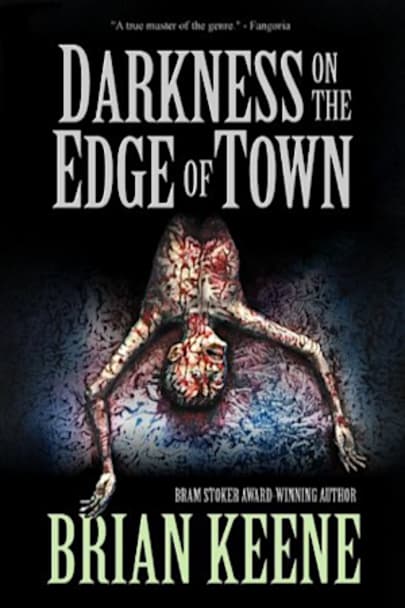One morning the residents of Walden, Virginia, woke up to find the rest of the world gone. Just . . . gone. Surrounding their town was a wall of inky darkness, plummeting Walden into permanent night. Nothing can get in – not light, not people, not even electricity, radio, TV, internet, food, or water. And nothing can get out. No one who dared to penetrate the mysterious barrier has ever been seen … seen again. Only their screams were heard. But for some, the darkness is not the worst of their fears. Driven mad by thirst, hunger, and perpetual night, the residents of Walden are ready to explode. The last few sane prisoners of this small town must prepare a final stand against their neighbors, themselves, and something even worse . . . something out there . . . in the darkness.
more



On his podcast, The Horror Show with Brian Keene, Keene has mentioned a few times that Darkness on the Edge of Town was partly inspired by Stephen King’s The Mist. Commonalities certainly exist, but there’s also more than a touch of King’s Under the Dome, as if Keene and King had tapped into similar wavelengths and wrote their works concurrently, and likely unbeknownst to each other. King’s Dome was published at the tail-end of 2009, and the first edition of Darkness was published by Leisure Books at the start of 2010, so clearly something was in the air, reaching into their minds from the beyond. I mention this only because there’s a cool kind of synchronicity that can exist between creators and it fascinates and amuses me in almost equal measure that in being influenced by a much earlier King story, Keene wrote a somewhat similar story to a then-more current King tome (even if Dome itself is highly derivative of earlier, superior King books). For my money, though, Darkness on the Edge of Town is easily the better of the two.
As the title indicates, darkness is the predominate theme to this particular work. The town of Walden has been blanketed in perpetual night thick enough to blot out the stars. This darkness encases the town, and to leave Walden is suicide (but staying put could also mean certain death). Those who cross the city limits are never seen again, the violent cries of their death throes the final thing that is ever heard from them. Trapped within this small-town, madness begins to take hold as time loses all meaning and supplies begin to grow as scarce as hope.
Darkness on the Edge of Town is, suitably, a dark story. Darkness infests the town as much as it soaks the pages, and the people of Walden are driven toward their baser instincts, guided by their own inner darkness and personal torments. Keene slowly ramps up the violence, escalating from grocery store looters to gang-infested streets, home invasions, and rapes and murders that occur right in the middle of the street. It’s bleak, but compulsively readable. I had to know what secrets the darkness held, and whether or not Robbie, Christy, and their neighbors were going to survive this endless night.
I also had to know if and how this book tied into the larger mythos underpinning Keene’s narratives. Once the homeless man, Dez, made his appearance and began spouting off arcane craziness, my ears perked right up at the familiar concepts the fine folks of Walden brushed off as insane drivel. My patience was rewarded, and I can say that Darkness on the Edge of Town is most certainly one of the levels in Keene’s overarching Labyrinth mythology. I got hints of it in the Clickers books he wrote with J.F. Gonzalez, as well as The Rising, City of the Dead, and The Complex, so I was absolutely delighted to see more of that mythology discussed and elaborated on here.
I’m a sucker for multiplicative Earth’s and alternate realities and I dig the way Keene has merged scientific principles, like string theory and quantum mechanics, in a very layman way, with mythological stories to create a multi-storied overarching narrative to connect his works. Best of all, though, is that each of these works function independently. You need not have read The Rising to understand Darkness on the Edge of Town, but if you have you’ll find some sweet name-drops along the way. This book in particular is a solid stand-alone, but it’s made richer by the baked-in connectivity to Keene’s other works.
While all that stuff is certainly cool to be sure, the story surrounding all these little Easter Eggs is just as good. I dug the characters and how they responded to the darkness encroaching upon both the town and their psyches. There’s some great interpersonal dynamics at play, as well as some smaller examinations of mob mentality and how vicious and extreme human behavior can get in dire, pressing situations. Darkness is a bleak read on the whole, but a highly infectious one. Like Robbie and his neighbors, the darkness got into my head, too, and it forced me to keep turning the pages. Thankfully, I had plenty of light to read by.